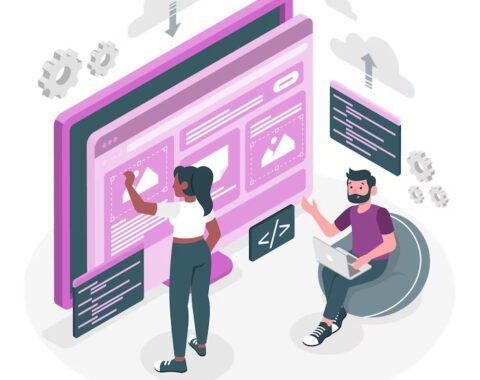In the ever-evolving landscape of web design and development, standing out from the crowd requires more than just building functional websites—it demands innovation. As technology advances and user expectations grow, web designers and developers must push the boundaries of their craft to create immersive, cutting-edge experiences that captivate audiences. Let’s explore the importance of innovation in web design and development, highlighting key trends, strategies, and tools to inspire the next wave of digital creativity.
The Evolution of Web Design and Development
Web design and development have come a long way since the early days of static HTML pages. The dynamic nature of the internet has led to continuous advancements, from the introduction of CSS for styling to the rise of responsive design and the incorporation of interactive elements through JavaScript. As we stand on the precipice of a new era, the need for innovation is more pressing than ever.
1. User-Centric Innovation
Innovation in web design starts with a deep understanding of user behavior and preferences. User-centric design involves empathy, observation, and feedback loops to create websites that not only meet but exceed user expectations. Engaging with users through surveys, usability testing, and analytics provides valuable insights, guiding the iterative process of improvement.
2. Immersive Experiences with AR and VR
Augmented Reality (AR) and Virtual Reality (VR) are no longer confined to gaming and entertainment; they have entered the realm of web design. Integrating AR and VR technologies into websites can provide users with immersive experiences that go beyond conventional interfaces. From virtual product try-ons to interactive 3D environments, these technologies open new avenues for creativity.
3. Progressive Web Apps (PWAs) and Offline Experiences
With the increasing reliance on mobile devices, the importance of Progressive Web Apps (PWAs) has grown. These apps offer a seamless experience across devices and platforms, incorporating features like offline functionality. By prioritizing performance and user experience, PWAs are pushing the boundaries of what’s possible on the web, delivering app-like experiences without the need for installations.
Strategies for Innovative Web Design
1. Incorporating Microinteractions
Microinteractions refer to discreet animations or feedback loops strategically designed to elevate user engagement. From a subtle button animation to a loading spinner, these small details contribute to a more polished and enjoyable user experience. By focusing on microinteractions, designers can inject personality into websites and create memorable interactions that keep users coming back.
2. Experimental Layouts and Typography
Breaking away from traditional grid-based layouts opens the door to experimental design. Asymmetrical layouts, overlapping elements, and non-traditional navigation structures can create visually stunning and unique websites. Similarly, innovative typography choices can set the tone for a brand, contributing to a distinct and memorable identity.
3. AI and Machine Learning Integration
The integration of Artificial Intelligence (AI) and Machine Learning (ML) into web experience by tailoring websites to individual preferences. This level of personalization not only improves user satisfaction but also increases the likelihood of conversion and user retention.
4. Dark Mode Design and Accessibility
Dark mode has transitioned from being a trend to becoming a standard feature in web design. Beyond its aesthetic appeal, dark mode enhances accessibility by reducing eye strain and increasing readability in low-light conditions. Web designers are innovatively incorporating dark mode into their designs, providing users with a choice that goes beyond the traditional light mode.
Tools and Technologies Driving Innovation
1. WebAssembly (Wasm)
WebAssembly is a groundbreaking technology that enables high-performance execution of code on web browsers. It allows developers to write code in languages like C, C++, and Rust, opening new possibilities for web applications. With Wasm, web developers can create complex, resource-intensive applications that run seamlessly in the browser, challenging the limitations of traditional web technologies
2. Voice User Interface (VUI) Development
Voice User Interface (VUI) development is transforming the way users interact with websites and applications. Integrating voice commands and responses adds a new layer of interactivity, especially in the era of smart devices and virtual assistants. Developers are exploring innovative ways to incorporate VUI, providing users with hands-free and intuitive interactions.
3. Low-Code and No-Code Platforms
Low-code and no-code development platforms empower individuals with varying technical expertise to participate in the web development process. These platforms use visual interfaces and pre-built components, reducing the need for extensive coding. As a result, web development becomes more accessible, fostering a culture of innovation among designers and developers alike.
In the dynamic system of web design and development, the mantra “Don’t Just Build, Innovate” has never been more relevant. Embracing user-centric design, experimenting with new layouts, integrating emerging technologies, and adopting sustainable practices are all crucial components of pushing the boundaries of innovation.
In this fast-paced digital landscape, TechnoRadiant recognizes the importance of staying ahead of the curve. With a commitment to sustainability, accessibility, and user satisfaction, we aim to create websites that not only meet but exceed expectations. At TechnoRadiant, we believe in the power of collaboration and creativity to shape the future of the web. By leveraging the latest tools and technologies, we empower our team to push the boundaries of what’s possible, delivering web solutions that captivate and inspire.
As we look to the horizon, TechnoRadiant remains dedicated to innovation, ensuring that every website we create reflects our commitment to excellence. As we continue to advance, the collaboration between designers, developers, and technology will drive the future of the web. By staying informed about the latest trends, leveraging cutting-edge tools and technologies, and fostering a mindset of continuous improvement, web professionals can ensure that their work not only meets current standards but also shapes the digital landscape of tomorrow.



